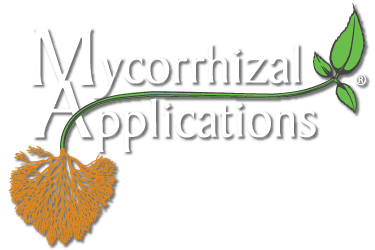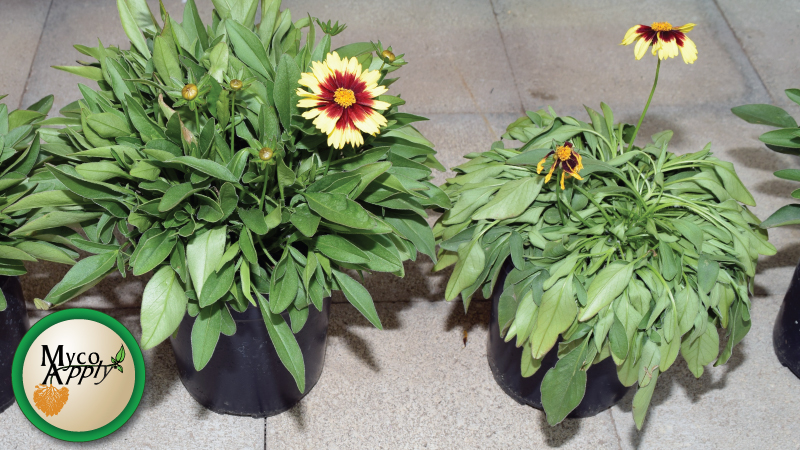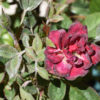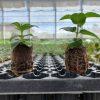Why Mycorrhizae, Why Now?
Mycorrhizae are not new, in fact they have been around for hundreds of millions of years. But the knowledge of how a horticultural professional can successfully use mycorrhizae has been emerging more and more in recent years. When plants started to associate with mycorrhizal fungi in nature, the symbiotic (mutually beneficial) relationship formed to help plants to survive under stressful conditions. Today, growers need to consider using mycorrhizae to be more competitive in today’s ever-changing marketplace.
Every grower is unique, depending on their production capabilities, customer base, etc. The benefits of using mycorrhizae in your production system and as an active ingredient in your finished product are also unique. To keep it simple, mycorrhizae expand a plant’s root mass. And by expanding a plant’s root mass, the mycorrhizal fungi are able to supply inorganic nutrients and water movement to the plant, and in return the plant ships surplus sugars back to the mycorrhizae.
Benefits that Matter to the Grower
Now how does that benefit a grower that produces plants in an ideal environment where nutrients and moisture are never lacking? Mycorrhizae allow your plants to be more competitive in the sequestering of the nutrients and water that you are providing to your plants. Even when water and nutrients are not deficient, mycorrhizae still expand the root masses of the plants and provide benefits.
A plant without mycorrhizae typically uses a small portion of the nutrients that are applied by the grower. Mycorrhizae greatly increase the percentage of nutrients absorbed by the plant. The fungus does this in two ways. First they extend their mycelium network beyond the normal root zone and secondly, they extract more nutrients within the root zone because the mycelium is finer than plant roots or root hairs thus improving the overall nutrient uptake due to the increased surface-absorptive area. They also have the ability to transform nutrients into forms that plants can more readily absorb. For example, they can secrete organic acids that dissolve or chelate many ions, or release them from minerals and converting these nutrients into available forms that the plants can use. This is especially important in root-constrained situations i.e., in containerized plants, where roots are limited to a small volume and there is no possibility for the roots to explore larger soil volumes. Additionally, mycorrhizae can store nutrients when they are in excess, and supply them to the plant later when they are needed.
Since commercial growers began utilizing mycorrhizae in the 1990’s, we have learned a lot about plant nutrition. Where the norm used to be using a 20-20-20 fertilizer, to now when growers use a 20-10-20 fertilizer, or better yet a 15-5-15 or 15-2-15 fertilizer and grow in soil-less media to produce the same crop. With these changes, nitrogen levels have dropped from historic levels of 200-400 ppm N to 100-150 ppm N by comparison. As growers have reduced their nitrogen levels, their phosphorus levels have dropped, as well. Historically, these higher levels of water-soluble nitrogen and phosphorus have suppressed mycorrhizal activity because there was no mutual need of the host plant and fungus to form a symbiotic relationship.
All of these nutritional changes have created plants with stronger/harder shoot and root growth, a greater resistance to plant disease and reduced fertilizer costs for the grower. The advent and increased use of controlled release fertilizers and organic fertilizers have also changed the landscape. All of these changes have opened the door for the use of mycorrhizae. Mycorrhizae allow plants to do more with less. Growers can reduce their fertilizer usage on a finished crop by 25-40% and still deliver the plant quality desired by retailers. The reduction in fertilizer and the greater utilization of the fertilizer by the plant also reduce nitrogen and phosphorus run off. What is amazing is that growers that do not reduce their fertilizer usage will still benefit from the use of mycorrhizae, because their plants will use more of what is applied and less will go to waste through the bottom of the pot. The expanded root mass derived from the use of mycorrhizae also benefits the plant by allowing it to access more of the moisture applied to the plant. This can also benefit the grower when they are struggling to get caught up with their watering due to warmer weather during production.
Benefits to Your Customer, the Retailer or Landscaper
Once your plants are loaded on a truck and out of your care, they typically start to decline in quality due to the lack of nutrition and moisture. Growers that grow with mycorrhizae benefit in that once the plant is treated with mycorrhizae everyone else further down the value chain benefits from their decision. First the plant comes out of the truck looking better, because the plant could better handle stress during shipment. Second, nutrients will be available to the plant longer, as the plant accesses the last feeding, and as the nutritional stores in the mycorrhizae are made available to the plant. Third, water will be extracted by the mycelium network of the mycorrhizae combined with the water reserves stored in the same network; treated plants can typically resist wilt 24-48 hours longer than untreated plants. Fourth, plants that look better sell quicker, they have greater shelf appeal. Plants grown with mycorrhizae look better longer, thus they have a longer shelf life and there is less dump or less plants make it to the mark-down bench. And fifth, home gardeners and landscapers benefit from getting a plant that is better prepared to survive transplant shock. Once a treated plant is planted in the landscape, they immediately begin to expand their root mass. And as they expand their root mass the plant is better able to access nutrients and water and ultimately survive the transition. Long term the plant is better able to thrive, producing the desired flowers and fruits, thus creating a happy customer that returns to buy more from the grower or garden center.
Keys to Success
- A mycorrhizae treatment does not have an immediate impact. Typically mycorrhizae need eight weeks on average to start to demonstrate visual benefits to the grower. Benefits to the plant will begin within a few weeks of treatment, but the difference will be less noticeable. Early colonization (during propagation or when the plugs arrive) is most cost-effective, as young plants require less inoculum, produce a faster response, and the eight-week clock has started to count down. This is especially important for short term crops grown in greenhouses. For landscapers, it is never too late to top-dress or incorporate the mycorrhizae to an untreated plant. Mycorrhizae can be added at planting or to an established landscape.
- Mycorrhizal propagules need to be applied in close proximity to actively growing root tips, as the root exudates trigger the germination of the dormant propagules, and kick off the symbiotic colonization of the root system. MycoApply® can be applied as a seed treatment, applied to unrooted cuttings, incorporated into growing media, or even used as a drench or plug tray dip. The key is to mix the propagules thoroughly in the soil or to apply sufficient water volume to move them into the future root zone of the plant.
- Mycorrhizal fungi are soil-borne fungi that may be susceptible to certain fungicide products. More information on this topic is on the Mycorrhizal Applications website. A website document titled “Effects of Fungicides on Mycorrhizal Fungi” gives an overview of our present knowledge of the compatibility of mycorrhizal fungi and fungicides. Many common fungicides are compatible with mycorrhizal inoculation and development. The inoculation stage is the most susceptible period. The longer the wait to apply any fungicide after mycorrhizal fungi inoculation, the better for the mycorrhizal development. We suggest waiting at least two weeks to avoid slowing the mycorrhizal inoculation. Most foliar applied fungicides (except systemics, such as Strike®) have little effect on the mycorrhizal fungi.
- Diversity matters when it comes to mycorrhizal fungi. Having multiple species is critical to achieve maximum efficacy of the mycorrhizae. There are over three hundred known species of endo mycorrhizal fungi in the world. In the soul microbiome, the mycorrhizal fungal community changes over time with plant phenology, season, microclimate and soil conditions. Furthermore, different species are responsible for different functional benefits to the plant. This is analogous to why you take a multi-vitamin. Depending on the day, you might need more of a particular vitamin contained within the single pill; the same is true with plants and mycorrhizae, often the more species in the mix, the better. Independent research has shown products containing multiple mycorrhizal species provide more consistent benefits to the plant and ultimately to the grower. Even if you purchase a growing mix that has a single species of mycorrhizae already included, your plants will still benefit by being treated with a MycoApply® multiple-species offering.
- Not to complicate things, but it is also important to treat the right plants with the correct mycorrhizae. Almost 85% of all plants are Endomycorrhizal. This includes most greenhouse crops. About 10% of plants are Ectomycorrhizal. This mostly includes conifers and hardwood trees. Orchids and Ericaceae plants have their own unique types of mycorrhizae that are not commercially available in North America. A few horticultural important crops are non-mycorrhizal. They include brassicas, spinach and the Caryophyllaceae family (Carnation, Dianthus, etc.). If you treat a plant with the wrong mycorrhizae or a plant that is not mycorrhizal, you will not harm the plant. Click here for a list of families and genera and their mycorrhizal affiliation.
- If you plan to run a mycorrhizal trial, you should only have one variable. The treatments should be 1) standard production practices without mycorrhizae versus 2) standard production practices with mycorrhizae. This will allow you to isolate the value that mycorrhizae offer to your business.
If you have any questions about the information contained in this article, please contact Mycorrhizal Applications at 866-476-7800 or email us at inquiries@mycorrhizae.com.
Blair Busenbark
Mycorrhizal Applications – Sales & Commercial Marketing Manager
January 12, 2018
© 2018, Mycorrhizal Applications LLC







